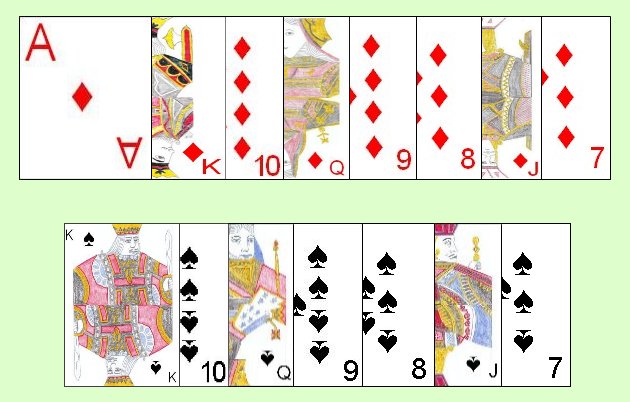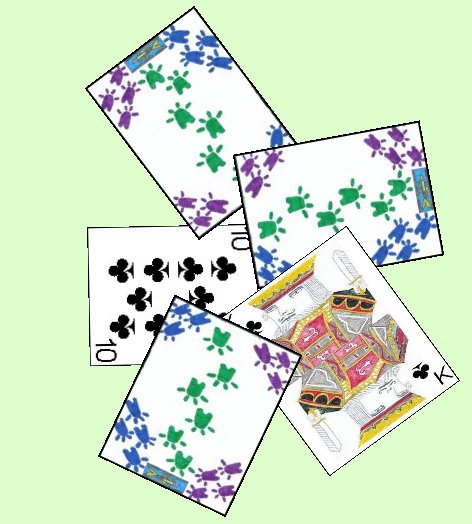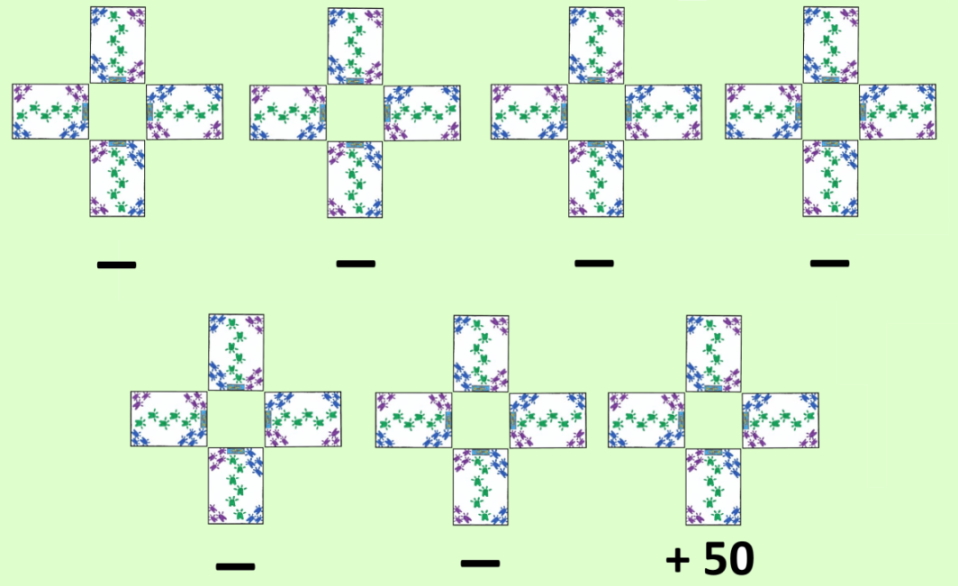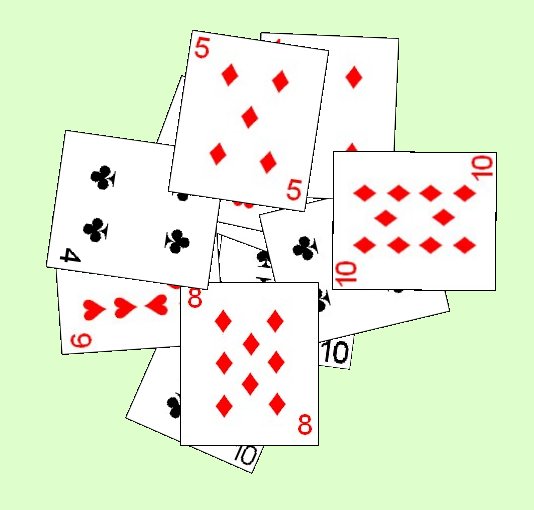There are several games similar to Agram that are played in other regions which are equally as popular. These include some of the following:
Sink Sink: This game is a common variation of Agram played in the same region as the parent game. Sink Sink is played nearly identical to Agram except for one major difference.
This difference being the number of cards received by the player. In Sink Sink, each player thus only receives 5 cards instead of six as in Agram. When dealing, the cards are distributed in two rounds. The first round, each player is dealt 3 face down cards and on the second round a packet consisting of two such cards. After each player receives his five cards, the hand begins. As in most other related games, the player to win the last trick of the hand is declared the winner.
Because each player receives only five cards, Sink Sink is suitable for up to seven players.
Reduced Deck: In the variation of Agram most commonly played in the Mali region, each player is dealt five cards. When playing this version, the following cards are removed from a standard 52 card deck before beginning play: All Sixes, Fives, Fours, Threes and Twos. As in all other versions of Agram, the Chief (Ace of Spades) is also removed from the deck.
The ranking of the cards in this version is quite different than that in standard Agram:

- In the suits of (♦) Diamonds, (♥) Hearts and (♣) Clubs the ranking would be: Ace, King, 10, Queen, 9, 8, Jack, 7.
- In the suit of (♠) Spades the ranking is: King, 10, Queen, 9, 8, Jack, 7.
Other than the modified card ranking and fewer cards dealt, the game is played identically to the standard game.
FapFap: This variant of Agram is played most often in Cameroon. This
version uses the same deck and card ranking as in the base game of Agram. FapFap is played similarly to that standard game with a few key differences.
In FapFap, the player winning the fifth and last trick of the hand earns a number of Game points based on certain criteria:
- If the winner of the last trick is able to win both of the last two tricks using threes, he wins four Game points.
- If the winner of the final trick is able to win only the last trick with a three, he earns two Game points.
- Winning the last trick with any card other than a three earns the player one Game point.
Spar: Spar appears to be the game in which Agram and it's variants were derived from. Spar uses a standard deck with the following card denominations removed: All Twos, Threes, Fours and Fives. The Ace of Spades is also removed from the deck used for Spar. Spar is most commonly played in the country of Ghana.
Each player receives five cards dealt in face down packets of three cards and then two cards. The game is played very similarly to FapFap, with the winner of the fifth and final trick earning Game points based on the card used to win that last trick:
- If the last trick was won with a six the winner earns 3 Game points.
- If the last trick was won with a seven, the winner earns 2 Game points.
- If the last trick was won with any card except a six or seven they win 1 Game point.
The winner of each hand is the dealer for the next hand. In all other respects this game is played identically to FapFap.
Sipa: Sipa is a variation of Agram that is commonly played in Togo. It is played by from 2 to 5 players and the deal, play and movement of the deal all take place in a counter-clockwise direction.
The deck used for Sipa is the same as in the Reduced Deck version of Agram described above. However, the ranking of the cards in this game is more traditional:
- In the suits of Diamonds (♦), Hearts (♥) and Clubs (♣): Ace, King, Queen, Jack, 10, 9, 8, 7.
- In the suit of Spades (♠): King, Queen, Jack, 10, 9, 8, 7.
As in many other of the related variants, the dealer distributes five cards to each player, first dealing a packet of three and then a packet of two.
If a player's card to be played cannot beat the current high card to the trick, the normal custom is to play the card face down next to himself, not exposing the card.
Similar to several other variations of Agram, the player who wins the fifth and last trick earns game points based on cards used to win that and immediately previous tricks, as follows:

- If the player winning the last trick was able to win the last three tricks all with sevens they earn 6 Game points.
- If the player winning the final trick was able to win the last two tricks with sevens, they win 4 Game points.
- If the player winning the last trick was able to win the last trick with a seven, they earn 2 Game points.
- For winning the last trick with any card but a seven, that player earns 1 Game point.
The first player to win a set number of Game points is declared the overall winner. This number is usually set at 10, however, for a longer game, some players prefer to play to 30 points.
Although most people record each player's score using a pen or pencil and paper, a more traditional method which is sometimes used is to use stones or pebbles to keep score. Using this method, a pile of 10 (or 30 for the lengthier game) similarly sized stones are placed in the middle of the table. As players earn points during the game, they would then take a stone from the pile, adding it to his collection. Once all 30 stones have been taken, each player then counts the number of stones they have collected, and the player with the most stones is declared the game winner.
Jeu de Carte: In the nation of Benin, a game is played by the name Jeu de Carte which is very similar to Agram. As in Agram, Jeu de Carte is designed for play by 2 to 5 players and uses the same deck reduced deck as in that game. The only differences in Jeu de Cartes from that game are the following:
- The player cutting the cards places the cut portion of the deck next to the remainder of the deck, in two piles. The dealer then deals the cards using the top of the lower stack from the cut, dealing each player five total cards in a batch of three cards and then two cards. If the cutter opts not to cut (instead simply tapping the top of the deck), the dealer deals from the entire deck.
- Instead of playing the card in the tricks to the center of the table on their turn, they instead play the card face-up in front of themselves. If a player plays a card that is not of the suit led to the trick, he plays his card face-down instead, since he cannot win that trick anyways.
- Winning the last trick with any card other than a seven earns the player 1 point. If the winner of the last trick manages to win it with any seven, he wins two points instead.
- The first player to reach a total of 24 points is declared the winner.
In all other respects, Jeu de Carte is played identically to Agram as described at the top of this page.
Cat Tê: Cat Tê, also sometimes written as Catte is a Vietnamese game with the same general goal as in Agram and most of it's variations; to win the last trick of each hand. Cat Tê uses a standard 52 card deck and is usually played by from 3 to 6 players. The ranking in this game is as follows (from high to low); Ace, King, Queen, Jack, 10, 9, 8, 7, 6, 5, 4, 3, 2.
One possible scoring method in this game is to use chips or tokens. Before the start of the game, each player should be provided with an equal number of these chips. If during the game a player runs out, another equal batch can be distributed to all players to allow any players who may have run out of chips to continue play.
Determination of first dealer and seating positions can be performed in any manner, with a cut for high card common. After initial determination of seating positions, the dealer proceeds to shuffle the deck and deal six face-down cards to each player one-by-one in a counter-clockwise rotation. Dissimilar to most games, the dealer in Cat Tê also takes the first turn. After the first hand, the winner of the previous hand has the privilege of being the dealer. After receiving his cards, a player may then examine his hand.
If a player, in his own hand has a hand consisting of four cards of the same suit or all six cards in his hand are of the same suit (a flush), he instantly wins the hand and each opponent must give him a penalty of two chips from their own pile.
The dealer leads the first card to the first trick. After the first trick is played, the winner of the previous trick during the hand leads the first card to the next trick.

When leading to a trick, a player may lead any card currently remaining in his hand. The subsequent players, in a counter-clockwise direction then play one card from their own hand to the trick. A player is not obligated to follow suit nor to attempt to win any trick. The normal custom in this game, when playing a card that cannot win the current trick, is to play that card face down to the trick. A card played in that manner is not exposed and can never win a trick.
The highest card of the same suit as that originally led to the trick wins the trick. The winner of each trick leads the first card to the next trick.
After the first four tricks are played there is a momentary pause in the action. If one player managed to win all four of these first four tricks, they immediately win the hand. When winning the hand in this way, all opponents must give the winner two chips from their own collection. Similarly, a player who did not manage to win at least one of these first four tricks must drop from this hand.
After this fourth trick, the winner of the fourth trick leads a card from his hand face up to the trick. The remaining players then all place their card to that trick face down. After all players have played, these cards are turned over to reveal their face. As in the first four tricks, the highest card of the led suit wins the trick. The winner of the fifth trick then leads to the last trick. Each other player then plays their own last card to the trick. The highest card of the suit led wins this trick and also the hand.
The winner of the hand earns one game point or chip for each opponent in the game and becomes the dealer for the next hand. After a set number of hands, the player with the most chips or highest game point total is the winner of the game session.
This game is also usually played using an Ace Sandbagging penalty. Sandbagging in this game is when a player withholds an Ace, not playing it when able in an earlier trick, and instead electing to save it for a critical trick and subsequently another player wins the first four tricks and thereby winning the hand. This situation occurs when the eventual winner of the first four tricks leads the first 3 with the same suit as the Ace and the owner of that Ace (another player) does not play it when able. When this occurs, the owner of that Ace who did not play it loses one game point or chip.
Eighty Three: Eighty Three is a close variant of Cat Tê and is played somewhat similarly to that game. The main difference between the two is that in Eighty Three the goal is to win the fifth trick instead of the last. It also features a somewhat different scoring system.
Eighty Three can be played by 2 to 8 players, and is best for 3 to 6. It uses the standard 52 card deck which ranks as follows in each suit (from high to low); Ace, King, Queen, Jack, 10, 9, 8, 7, 6, 5, 4, 3, 2.
Seating positions and first dealer can be decided in a variety of ways, with drawing for high card a common method. Once this is decided, the dealer shuffles and deals six card hands to each player, face down and one card at a time. Dealing, play of the hand and rotation of the deal itself all occur in a clockwise rotation.
The player to the dealer's immediate left plays the first card to the first trick. Each other player, in a clockwise rotation, must then play one card to the trick. A player must follow suit to that originally led to the current trick if able. If the player does not have a card of the led suit they may play any card in their hand to the trick. The highest card of the suit originally led to the trick wins it. The winner of each trick leads the first card to the next trick. The hand continues in this way until all six tricks have been played and won after which scoring for the hand occurs.
Scoring: The player who won the fifth trick is considered the winner of the hand and is awarded two points. If this trick was won with a card other than an Ace, this player wins one additional point. If that same player did NOT win the last trick of the hand, he wins one more point.
If any player, at the start of the hand holds any four of a kind or six cards of the same suit, they also win one point.
Winning the Game: After scoring of each hand, if any player reaches or exceeds 10 points he is declared the winner. If two or more players reach or exceed 10 points, the player with the highest score wins. If the highest scores are tied, the winning threshold is raised to 15 points and the game continues with all current players. If another tie occurs, breaking the 15 point threshold the total is raised 5 more, continuing to be raised by five points until there is a clear winner.
Letzter Stich: Letzter Stich is a German game with a similar goal to Agram and other similar games,
which is to attempt to win the last trick of each hand. The name of the game, translated to English means "Last Trick". Letzter Stich should not be confused with another German game with the similar name Letzter, but the goal of that game is to avoid winning the last trick of the hand. The rules for this other game, Letzter, can be found at
this location.
Letzter Stich normally uses the standard Skat deck of cards. This deck can be created by removing all cards from a standard deck except all cards of denominations Ace, King, Queen, Jack, 10, 9, 8, 7. The ranking of the cards in this deck, as used for this game, are as follows (from high to low): Ace, 10, King, Queen, Jack, 9, 8, 7.
Letzter Stich can be played by four, five or six players, with an almost identical version for three players described further below.
Determination of seating positions and first dealer can be performed using a variety of methods, with draw for high cards a very common method. Using that method, each player draws one card from the shuffled deck, taking a seat at the table in order of rank of cards drawn, from highest to lowest. If two or more players draw cards of the same ranking, those players would discard that card and draw another card, continuing to draw cards until draw a card of a rank that no other player has yet drawn. The player drawing the highest card of all is set as the first dealer. After each hand, the role of dealer rotates around the table in a clockwise direction.
After the players are seated and the first dealer determined, the dealer should thoroughly shuffle the deck. After shuffling, he offers the pack to the player at his right to cut. After the cut he begins dealing the cards in a clockwise direction around the table, one by one and face down, starting with the player at his immediate left. The number of cards dealt to each player is dependent on the number of players in the game. The following chart shows the cards dealt based on the number of players in the game:
| Number of Players | Cards Dealt Per Player |
|---|
| 4 | 7 |
| 5 | 6 |
| 6 | 5 |
|
|

|
The remaining cards in the deck after the deal are set aside, not used for the rest of this hand. The player to the immediate right of the dealer leads the first card to the first trick. He may lead any card of choice from his hand. Each other player in a clockwise direction from the leader, then plays one card to this trick. If the player has at least one card of the same suit as that led he must play such a card. If he does not have a card of the suit originally led to the trick he may play any card from his hand to the trick. The trick is won by the player of the highest card of the suit originally led to the trick. The cards from the trick are set aside, face-down, and the winner of the trick then leads any card of his choice remaining in his hand to start the next trick. The game continues in this manner until all players have no cards remaining. The player who wins the last trick of the hand earns 50 points.
The game is usually played for a certain number of hands, which should usually be an even multiple of the number of current players. After this set number of hands has been played, the player with the highest accumulated score is declared the game winner. Alternatively, a target score can be set (such as 500) and the first player to reach this score is declared the winner.
Letzter Stich for Three Players: Letzter Stich can also easily be played by three players. In this variant, the normal deck as used for Letzter Stich is further reduced by also removing the four eights, creating a 28 card deck. Each of the three participants in the game
thus receives 8 cards and the remaining cards in the deck are set aside,
not used for the rest of this hand. In all other aspects the three
player variant of Letzter Stich is played identically to the variant of
this game described above for four or more players.
Copyright © 2015 CatsAtCards.com. All rights reserved.
 Agram is a trick winning card game that is commonly played in Africa, particularly in
the country of Niger. What makes this game unique is that players score nothing for winning individual tricks but instead, win by capturing the last trick of the hand. Although the games name, Agram, translates to "First" in several languages spoken in the area where the game is played, the actual focus of the game is actually the last trick of the hand. This game is designed to be played by 2 to 5 players.
Agram is a trick winning card game that is commonly played in Africa, particularly in
the country of Niger. What makes this game unique is that players score nothing for winning individual tricks but instead, win by capturing the last trick of the hand. Although the games name, Agram, translates to "First" in several languages spoken in the area where the game is played, the actual focus of the game is actually the last trick of the hand. This game is designed to be played by 2 to 5 players.

 When leading to a trick, a player may lead any card currently remaining in his hand. The subsequent players, in a counter-clockwise direction then play one card from their own hand to the trick. A player is not obligated to follow suit nor to attempt to win any trick. The normal custom in this game, when playing a card that cannot win the current trick, is to play that card face down to the trick. A card played in that manner is not exposed and can never win a trick.
When leading to a trick, a player may lead any card currently remaining in his hand. The subsequent players, in a counter-clockwise direction then play one card from their own hand to the trick. A player is not obligated to follow suit nor to attempt to win any trick. The normal custom in this game, when playing a card that cannot win the current trick, is to play that card face down to the trick. A card played in that manner is not exposed and can never win a trick.
